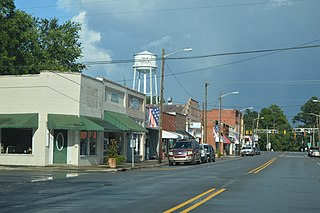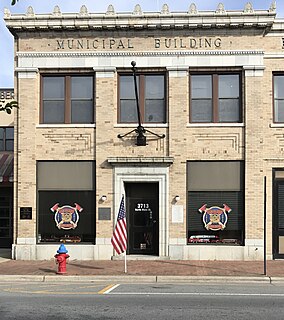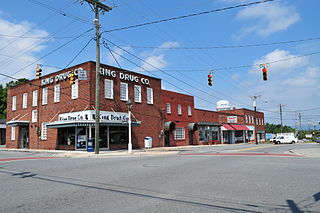
Green Level is an unincorporated community near the town of Cary in southwestern Wake County, North Carolina, United States. It was founded around 1800, and is one of the oldest surviving crossroads communities in the Raleigh area.

Halifax Historic District is a national historic district located at Halifax, Halifax County, North Carolina, US that was listed on the National Register of Historic Places in 1970 with an increase in 2011. It includes several buildings that are individually listed on the National Register. Halifax was the site of the signing of the Halifax Resolves on April 12, 1776, a set of resolutions of the North Carolina Provincial Congress which led to the United States Declaration of Independence gaining the support of North Carolina's delegates to the Second Continental Congress in that year.

Cape Lookout Village Historic District is a national historic district located near Core Banks, Carteret County, North Carolina. It encompasses 20 contributing buildings 1 contributing site, and 6 contributing structures in Cape Lookout Village. The buildings include notable examples of Queen Anne and Bungalow / American Craftsman style architecture. The district includes two government complexes: the Cape Lookout Lighthouse Station and the Cape Lookout Coast Guard Station. In addition, 14 buildings, a long dock, and the circulation network, as well as the landscape in which these lie, compose the district. The buildings include the Life Saving Station (1888) and Boathouse, the Keeper's Quarters (1907), Luther Guthrie House, Gaskill-Guthrie House, Seifert-Davis House, Baker-Holderness House, the Bryant House, and the Carrie Arendell Davis House.

Faison Historic District is a national historic district located at Faison, Duplin County, North Carolina. The district encompasses 116 contributing buildings, 2 contributing structures, and 1 contributing object in the central business district and surrounding residential area of Faison. It includes industrial, residential, and commercial buildings with notable examples of Greek Revival, Queen Anne, and Italianate style architecture. Notable buildings include the Cates Pickle Company (1931), Moore Lee Thornton Store, C. S. Hines Store, Clifton's Service Station (1933), The Walter Livingston Hicks House, Faison Pharmacy, Witherington Building (1915), Faison Depot (1888), Presbyterian Church (1918), Elias Faison House, Faison-Williams House (1853), and Witherington House (1880).

Belmont Historic District is a national historic district located at Belmont, Gaston County, North Carolina. It encompasses 264 contributing buildings, 1 contributing site, and 2 contributing structures in the central business district and adjacent residential areas of Belmont. The district was developed after 1873, and includes notable examples of Colonial Revival, Tudor Revival, and Bungalow / American Craftsman architecture. Located in the district is the separately listed U.S. Post Office, Former. Other notable buildings include the R.L. Stowe Mills Office Building, Bank of Belmont (1926), Piedmont and Northern Railroad Depot, Belmont Hotel, Abel C. Lineberger House No. 2 designed by Charles Christian Hook (1870–1938), Samuel Pinckney Stowe House, James W. Stowe House, Sacred Heart College, and Belmont High School (1939).

Scotland Neck Historic District is a national historic district located at Scotland Neck, Halifax County, North Carolina. It encompasses 249 contributing buildings and 1 contributing object in the central business district and surrounding residential sections of the town of Scotland Neck. The district includes notable examples of Greek Revival and Gothic Revival style architecture. Located in the district is the separately listed Hoffman-Bowers-Josey-Riddick House. Other notable buildings include the Fenner-Shields-Lamb House (1827); D. Edmondson Building, E. T. Whitehead drug store ; Scotland Neck Bank (1914); Baptist Church (1917); Trinity Episcopal Church (1924); and town hall and fire station (1939), brick gymnasium and vocational building (1940), and one-story, elongated brick multiple housing unit (1943) built by the Works Progress Administration. The latter building was utilized as a prisoner-of-war camp during World War II.

Roanoke Rapids Historic District is a national historic district located at Roanoke Rapids, Halifax County, North Carolina. It encompasses 1,130 contributing buildings, 5 contributing sites, 27 contributing structures, and 1 contributing structure in the central business district and surrounding residential sections of the town of Roanoke Rapids. The district includes notable examples of Queen Anne, Colonial Revival, and Bungalow / American Craftsman style architecture. Located in the district is the separately listed Roanoke Rapids High School. Other notable buildings include workers houses in four local mill villages, Driscoll-Piland-Webb House, Dickens-Webb House (1906-1907), Samuel F. Patterson (1914-1915), Council-Coburn House (1925-1927), First Presbyterian Church (1915), All Saints Episcopal Church designed by Hobart Upjohn (1917), (former) First Baptist Church (1928-1929), (former) Nurses Home and School (1930-1931), Clara Hearne Elementary School (1933-1935), (former) North Carolina National Guard Armory (1940-1941), (former) United States Post Office (1937-1938), Rosemary Drug Co. Building (1915-1916), Shelton Hotel, First National Bank Building (1914-1915), J. C. Penney and Co. Building (1938-1942), McCrory Co. Building (1940), Imperial Theatre Building, (former) Seaboard Air Line Passenger Station (1917), Rosemary Manufacturing Company complex, Patterson Mills Co. (1910), and Roanoke Mills Co. Plant No. 2. (1916-1917).

Benson Historic District is a national historic district located at Benson, Johnston County, North Carolina. It encompasses 104 contributing buildings in the town of Benson. It includes notable examples of Late Victorian and Bungalow / American Craftsman style architecture and buildings dating from about 1900 to 1930. It includes commercial, residential, ecclesiastical, and educational structures. Notable buildings include the Farmers Commercial Bank (1921), C. T. Johnson Building (1910), James E. Wilson Livery Stable· and Store, Carolina-Parrish Hotel, Boon-Lawhorn House, Lonnie Stevens House, Dr. Parker-Allen House, Baptist Church (1914-1915), United Methodist Church (1917), and Benson Elementary School.

Downtown Selma Historic District is a national historic district located at Selma, Johnston County, North Carolina. It encompasses 59 contributing buildings and 1 contributing structures in the central business district of Selma. It includes notable examples of Classical Revival, Colonial Revival, Art Moderne, Art Deco, and Gothic Revival style architecture and buildings dating from about 1875 to 1960. Notable buildings include the Bank of Selma/American Telephone and Telegraph Exchange Building, Economy Furniture, John A. Mitchener Building (1925), The Rudy Theater, The Hardware Store, Bank of Selma, Selma Baptist Church, and Selma Manufacturing Company/Selma Furniture Store and Opera House (1902).

Star Historic District is a national historic district located at Star, Montgomery County, North Carolina. The district encompasses 85 contributing buildings, 2 contributing sites, and 3 contributing structures in the town of Star. The district developed between 1896 and 1963 and includes notable examples of Queen Anne, Romanesque Revival, Colonial Revival, and American Craftsman style architecture. Notable contributing resources include the Leach-Allen House and Wright Dairy, Leach Cemetery (1859), Star Railroad Depot, Bank of Star, Star Hotel (1896), Allen Building, Pontiac Dealership, Nalls Watch Repair Building/C. V. Richardson Hosiery/Star Town Hall, Star Methodist Church, and Star Presbyterian Church (1953-1958).

Aberdeen Historic District is a national historic district located at Aberdeen, Moore County, North Carolina. The district encompasses 101 contributing buildings, 1 contributing site, and 2 contributing structures in the town of Aberdeen. It was developed between 1880 and 1940 and includes notable examples of Queen Anne, Classical Revival, and Bungalow / American Craftsman style architecture. Located in the district is the separately listed John Blue House. Other notable buildings include the Postmaster's House, Aberdeen and Asheboro Railroad Building, Page Memorial Library (1907), (former) Union Station (1906), Aberdeen and Rockfish Railroad Building (1904), Bank of Aberdeen, Page Memorial United Methodist Church (1913), (former) Bethesda Presbyterian Church (1906-1907), and Faith Presbyterian Church.

Nashville Historic District is a national historic district located at Nashville, Nash County, North Carolina. It encompasses 142 contributing buildings and 3 contributing structures in the rural county seat of Nashville. The buildings primarily date between 1890 and 1930, and include notable examples of Greek Revival, Italianate, Queen Anne, Colonial Revival, and Classical Revival style architecture. Located in the district are the separately listed Bissette-Cooley House and Nash County Courthouse. Other notable buildings include Joyner's Recreation, Graphic Building, Baldy Batchelor Livery Stable, Weldon's Department Store (1913), Nashville Fire Department (1930), Ricks-Strickland House (1890s), Squire Harper House (1868), two metal-veneered "Lustron houses," Neville-Strickland House (1907), Primitive Baptist Church, First Methodist Church (1923), and former Baptist Church.

Spring Hope Historic District is a national historic district located at Spring Hope, Nash County, North Carolina. It encompasses 159 contributing buildings and 1 contributing structure in the small railroad town of Spring Hope. The buildings primarily date to the 19th and early 20th century, and include notable examples of Late Victorian and Bungalow / American Craftsman style architecture. Located in the district is the separately listed Dr. Hassell Brantley House. Other notable buildings include former Wilmington and Weldon railroad station, Bluford Brantley House, Sykes Seed Store, Spivey's General Merchandise, Citizens Bank (1908), A. F. May gasoline station (1923), Hill's Auto Service (1933-1934), Spring Hope Cotton Seed Oil Company, Joseph J. Spivey House, Cone-Brantley House (1887), Richardson-Chamblee House (1901), and Morgan-Vestor House (1923).

Richlands Historic District is a national historic district located at Richlands, Onslow County, North Carolina. The district encompasses 90 contributing buildings, 2 contributing structures, and 2 contributing objects in the central business district and surrounding residential sections of Richlands. The district largely developed after 1880 and includes notable examples of Late Victorian and I-house style residential architecture. Notable contributing buildings include the Robert D. Thompson House (1908), Daniel Webster Murrill House (1908), the Del Barbee House (1910), the Edwards-Cox House (1915), Isaac Koonce House (1918), George Brooks House (1915), Franck House (1914), Richlands Theater (1936), J. F. Mohn Building (1936), Richlands Supply Company Building (1905), M. B. Steed Store (1911), Peoples Bank Building, Bank of Richlands (1927), First Baptist Church (1920s), and Richlands United Methodist Church (1939).

Burgaw Historic District is a national historic district located at Burgaw, Pender County, North Carolina. The district encompasses 130 contributing buildings, 1 contributing structure, and 1 contributing object in the central business district and surrounding residential sections of Burgaw. The district developed from the mid-19th to mid-20th century, and includes notable examples of Gothic Revival and Queen Anne style architecture. Located in the district are the separately listed Burgaw Depot and Pender County Courthouse. Other notable contributing buildings include the M. M. Moore House, Murphy-Sasser House, Dr. H. B. Thomas House, Burton-Noel House (1917), Burgaw Presbyterian Church, Macedonia African Methodist Episcopal (AME) Church, Burgaw Methodist Church (1928), the Burgaw Baptist Church (1948), Bank of Pender (1907), Pender County Jail (1924), and R.H. Holland Motor Company Building (1924).

Farmville Historic District is a national historic district located at Farmville, Pitt County, North Carolina. The district encompasses 330 contributing buildings, 1 contributing site, and 2 contributing structures in the central business district and surrounding residential sections of Farmville. It includes buildings dated from about 1860 to 1942 and notable examples of Colonial Revival, Classical Revival, and Queen Anne style architecture. Notable buildings include the James W. May House, Fields-Rasberry House, Dr. David Morrill House, Warren Parker House, Nannie Smith House, First Christian Church (1910), Emmanuel Episcopal Church (1920), St. Elizabeth Catholic Church, Municipal Building (1928) possibly designed by Benton & Benton, Bank of Farmville (1921) designed by Benton & Benton, Pollard Auto Company Building, Paramount Theatre (1930s), J. Y. Monk Tobacco Warehouse, and East Carolina Railway Office and Freight Station.

Reidsville Historic District is a national historic district located at Reidsville, Rockingham County, North Carolina. It encompasses 324 contributing buildings, 1 contributing site, 11 contributing structures, and 1 contributing object in the central business district and surrounding residential sections of Reidsville. It was developed between about 1865 and 1941, and includes notable examples of Italianate, Queen Anne, American Craftsman, and Classical Revival style architecture. Located in the district are the separately listed Penn House and Gov. David S. Reid House. Other notable buildings include the Oaks-Motley House, Colonel A. J. Boyd House (mid-1870s), Reid Block (1880s), Citizens' Bank Building, William Lindsey and company Tobacco Factory, First Baptist Church, Main Street Methodist Church, Melrose (1909) designed by architect Richard Gambier, R. L. Watt house designed by Willard C. Northup, First Presbyterian Church (1922), St. Thomas Episcopal Church, Grand Theatre, Belvedere Hotel, United States Post Office and Federal Building, and the Municipal Building (1926).

Spray Industrial Historic District is a national historic district located at Eden, Rockingham County, North Carolina. It encompasses 70 contributing buildings, 9 contributing structures, and 1 contributing object in an industrial section of the town of Eden. It includes buildings associated with eight textile mill complexes, mill village housing, and seven commercial buildings. Notable contributing resources include the Smith River Dam and Spray Power canal, Morehead Cotton Mill complex, "Superintendent's" House, Imperial Bank and Trust Company (1912), Leaksville Cotton Mills complex, Spray Mercantile Building, Spray Cotton Mills complex, Lily Mill complex, Nantucket Mills complex designed by R. C. Biberstein, American Warehouse Company complex, Rhode Island Mill complex, Phillips-Chatham House, and Spray Woolen Mill complex.

Main Street Historic District is a national historic district located at Forest City, Rutherford County, North Carolina. It encompasses 61 contributing buildings, 1 contributing site, and 1 contributing structure in the central business district of Forest City. The district developed from the late 1880s through the 1920s, and includes notable examples of Classical Revival style architecture. Notable contributing buildings include the U.S. Post Office (1937), the Davis Sisters Building, the Farmers Bank and Trust building (1923), National Bank of Forest City (1923), the Tuberculosis Center (1902), the Romina Theater (1928), the Town Hall (1928) designed by James J. Baldwin, the Blanton Hotel (1925), the Reinhardt Drug Company Building, the First Wesleyan Church (1922), and the Florence Mill (1897-1941).

King Historic District is a national historic district located at King, Stokes County, North Carolina. The district encompasses 72 contributing buildings and 1 contributing structure in the central business district and surrounding residential sections of King. They were built between about 1914 to the 1950s and include notable examples of Colonial Revival and Bungalow / American Craftsman architecture. Notable buildings include the Bank of King, King Drug Company, Simeon Wesley Pulliam House, James Robert Hutchins House, King Milling Company, and King Moravian Church.



















